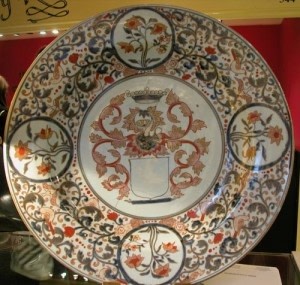In the centre a blank coat of arms with heraldic mantling and a blue and gilt coronet; the sides and rim with vigorously painted iron red and gilt foliate scrolls, with perched and flying birds and four reserved roundels filled with a flowering plant, under the base of the two roundels above and below the centre panel, a pair of little European figures holding a stem of the foliate scroll above their heads, the underside glazed, the footrim unglazed, with four or five spur marks on the base.
Literature
for a similar example in blue and white, see Fine And Curious; Japanese Export Porcelain in Dutch Collections, Christiaan J.A. Jorg, Hotei Publishing, Amsterdam, 2003, plate 294, page s 231-232. Jorg writes 'A similar dish in Imari enamels shows an identical blank shield. These dishes were meant to be finished in The Netherlands, with the buyer?s coat of arms applied by a Delft enameller. ' The decorative style of the foliage scrolls, the human figures and the birds indicate a European source, although the Chinese have used the motif of the boy in a lotus vine since the Song Dynasty. That the Imari version is almost identical to the example here suggests that one model may have been used for both of them.

